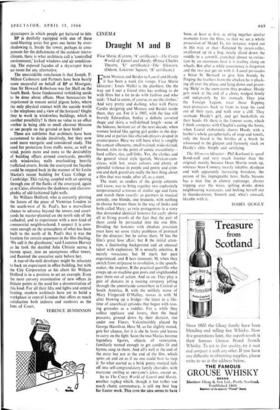ARCHITECTURE
Homo Bureaucraticus
THE chairmen of British Petroleum and Laing's, the contractors, recently joined in mutual congratulation on top of BP's new thirty- five-storey skyscraper in the City of London. They were topping out, a ceremony that used to involve bedding down the last brick or bit of masonry on some pinnacle or parapet, but which now involves splushing in the last skip of concrete.
The March sun shone, London spread away 395 feet below and the Shell building pulled a discreet shroud of mist about its shoulders. The BP men were delighted with the weather and pretty pleased with their fashionable new steel and glass clad building. They are confident they have avoided the opprobium that has been poured on Shell—a welter of anti-prestige probably un- paralleled in British architecture, which caused the designer of the Shell Centre, Sir Howard Robertson, to die an embittered man.
But superficialities aside, does an architectural monolith provide the best possible working conditions for homo bureaucraticus? The sky- scraper came into existence in the last century, when the invention of the elevator permitted square footage of lettable space to be stacked on to a site beyond the dreams of avarice. Chicago, where the practice began, and then Man- hattan island, where it was later copied, are text- book examples of what happens when an item of technology like a lift is allowed to run wild.
Le Corbusier tore the resulting skyscraper afforestation in shreds, and said the only justifica- tion for building high was to free space on the ground for parks; and, writing in the 'twenties, he did not mean car-parks. However, for one reason or another, no one ever managed to build office towers quite high enough, or to free enough ground around them, to create a park. The result has been those wind tunnel spaces at the foot of skyscrapers in which people get battered to bits.
BP is dutifully equipped with one of these sand-blasting areas but goes one better by over- shadowing it. Inside the tower, perhaps to com- pensate for the deficiencies of the outdoor micro- climate, there is what architects call a 'controlled environment,' locked windows and air condition- ing. The exposed facades of a skyscraper leave no room for any alternative.
The unavoidable conclusion is that Joseph, F. Milton Cashmore and Partners have been barely more successful on behalf of BP at Moorgate, than Sir Howard Robertson was for Shell on the South Bank. Some fundamental rethinking needs to be done about offices. Must bureaucrats be imprisoned in remote aerial pigeon holes, where the only physical contact with the outside world is the telephone and a view of the horizon? Ought they to work in windowless buildings, which is another possibility? Is there no value to an office worker in being able to smell chestnut blossom or see people on the ground or hear birds?
These are subtleties that architects have been accustomed to decide intuitively, but they now need more energetic and considered study. The need for protection from traffic noise, as well as wind, points more and more to the desirability of building offices around courtyards, possibly with windowless walls overlooking heavily trafficked streets. Inside the courtyard the facades could be stepped back in the manner of Sir Leslie Martin's recent building for Caius College at Cambridge. This raking, coupled with an opening through one of the flanks of the courtyard, again as at Caius, eliminates the dankness and claustro- phobia of old-fashioned light wells.
Sir William Holford, who is currently plotting the future of the piece of Victorian London to the south-west of St. Paul's, has a marvellous chance to advance beyond the towers and court- yards he master-planned on the north side of the cathedral, and to experiment with a new kind of commercial neighbourhood. I suspect it is com- ment enough on the atmosphere of what has been built to the north of St. Paul's that it was the location for certain sequences in the film Darling. 'We call it the glasshouse,' said Laurence Harvey as he took the dazzled Julie Christie across a barren space, into an anonymous office tower, and flaunted the executive suite before her.
Arun-of-the-mill developer might be reluctant to back an experiment in office building, but with the City Corporation as his client Sir William Holford is in a position to set an example. Even the most cursory examination of new offices in Britain points to the need for a demonstration of this kind. For all their lifts and lights and central heating, modern architects have yet to build a workplace in central London that offers as much satisfaction both indoors and outdoors as the Inns of Court.
TERENCE BENDIXSON



































 Previous page
Previous page